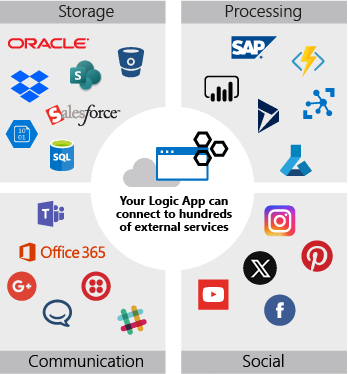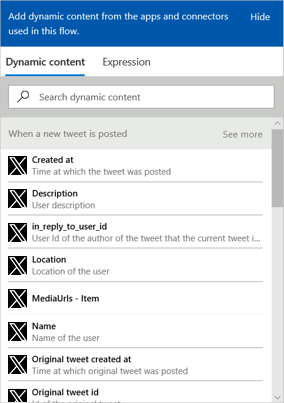Execute an action
Recall that a logic app workflow includes a trigger and actions. The trigger starts your workflow, and actions complete the remaining work. The news monitoring logic app uses actions to check whether an article is positive or negative, insert a row into a database, or send an email.
In this unit, we provide a quick overview for the action types. The unit then discuss how an action works by passing in parameters and processing returned values.
Action types
The core goal behind Azure Logic Apps is to help you make services and systems work together. To support this goal, Azure Logic Apps provides actions for the following tasks:
- Access other services, systems, apps, and data.
- Process and manipulate data.
- Control how data flows through your workflow.
Let's examine each action type.
Access services, systems, apps, and data
The most common action type helps you access and run specific tasks that work with services and systems outside your workflow in Azure Logic Apps. These actions are so common that most people mean this action type when they use the term action in reference to Azure Logic Apps. This action type provides access to 1,000+ products, including other Azure services, Microsoft services and products, Salesforce, SAP, Oracle, Dropbox, GitHub, Facebook, Twilio, Slack, Jira, and more. The following diagram shows a tiny fraction of the available actions:
When you use an action to connect from your workflow to an external service or system, you typically provide connection and authorization information. This information might include a username, a password, a connection string, or an account key. The details differ and vary for each service or system.
For example, to connect from your workflow to Azure Cognitive Services for Language, you provide a Site URL so that your workflow knows where to send the request to the service. You provide an Account Key to authorize your access to the service. You can get both values from your Azure AI account. Typically, when you add the Sentiment action to your workflow, you'll copy these values into the connection information box.
This action type helps your workflow send data for processing or pull data into your workflow. But how do you actually work with that data inside your workflow? The next action type helps with this task.
Process and manipulate data
This action type helps you process data or run operations on data that you pull into your workflow. For example, you have actions that can concatenate multiple values into a single string, parse JSON data, select specific values from an array, and so on.
Let's examine an example. If you've used Bing Search News, you might be familiar with this URL pattern that links to a specific news article:
https://www.msn.com/en-us/news/<category-name>/<article-name>
You can use this link type in the workflow for your news monitoring logic app. For example, you might want to store the URL link in a database so that you can access the article later. Or, you might want to include the URL link in an email so that your coworkers can review the article.
Control how data flows through your workflow
This action type helps you manage the way that data flows through your logic app workflow by using constructs such as conditions and loops. The news monitoring logic app workflow uses a control action that creates decision branches, based on whether the article sentiment is positive or negative. We show how this action type works and discuss all the control actions later in this module.
Action parameters and return values
You can think of a trigger operation as a function call that has parameters (inputs) and return values (outputs). Action parameters let you pass values into the operation. Some operations use both required and optional parameters. For example, the Azure Cognitive Services for Language action named Sentiment has a required parameter called Documents. This parameter represents the string that you want to analyze. The Sentiment action also has an optional parameter named Language that lets you provide a hint about the language used for the Documents parameter.
Action return values are the results or outputs from the operation. For example, the Sentiment action returns a sentiment ranking that is Negative, Neutral, Positive, or Mixed. The following diagram summarizes the data flow for the Sentiment action as used by our example news monitoring logic app:
Static versus dynamic parameters
Some parameters that you send to an action stay the same every time that your workflow runs. For example, you might want only articles in English, so you always pass en to the Language parameter in the Sentiment action. This type of static parameter is straightforward. You hardcode the value when you set up the action so that the action uses the same value every time that the action runs.
Other parameters that you send to an action can differ every time that your workflow runs. A good example is the Documents parameter in the Sentiment action. When you pass the article description into the Documents parameter, the description differs at every run. So, how do you get access to this dynamic value?
The article description that the workflow processes is the return value or output from the On new news article trigger. This article data is packaged into an object with several fields that contain the article's details. Azure Logic Apps automatically makes this object available to subsequent actions in your workflow. The workflow designer provides a visual way to easily add and configure actions in your workflow. The designer also helps you select available outputs that you want to use from the preceding trigger and actions in your workflow.
Actions in the designer
The workflow designer includes a connector gallery that contains the triggers and actions you can use in your workflow. Typically, you use the connector gallery search box to find and select a connector for your scenario. Then, you review any actions that the connector provides. The following screenshot shows how the workflow designer presents connectors for you to select:
After you select a connector, the actions available for that connector appear:
You can add an action to the end of your workflow or between existing steps. After you add an action, you can configure the action's parameter values using the designer.
While you can manually add static parameter values, the designer provides a different way for you to enter dynamic parameter values. When you select inside an edit box, options appear to open either the dynamic content list or the expression editor. The dynamic content list shows any outputs available from the preceding steps. You can select the data that you need, and the designer automatically populates the edit box in your action with your selection. The designer makes adding dynamic content easy. You don't need to remember parameter names and return values, nor do you need to worry about syntax details.
The following screenshot shows how the designer presents the dynamic data from the Bing Search trigger:
The next unit shows how to add and configure an action in the workflow designer.





